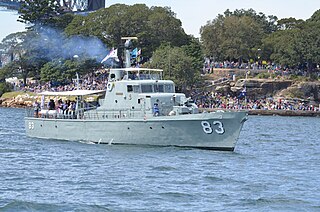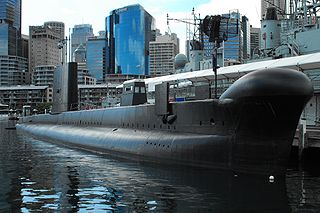
HMS Endeavour was a British Royal Navy research vessel that Lieutenant James Cook commanded to Australia and New Zealand on his first voyage of discovery from 1768 to 1771.

Port Jackson, consisting of the waters of Sydney Harbour, Middle Harbour, North Harbour and the Lane Cove and Parramatta Rivers, is the ria or natural harbour of Sydney, New South Wales, Australia. The harbour is an inlet of the Tasman Sea. It is the location of the Sydney Opera House and Sydney Harbour Bridge. The location of the first European settlement and colony on the Australian mainland, Port Jackson has continued to play a key role in the history and development of Sydney.

Duyfken, also in the form Duifje or spelled Duifken or Duijfken, was a small ship built in the Dutch Republic. She was a fast, lightly armed ship probably intended for shallow water, small valuable cargoes, bringing messages, sending provisions, or privateering. The tonnage of Duyfken has been given as 25-30 lasten.

HMAS Advance was an Attack-class patrol boat of the Royal Australian Navy (RAN). Constructed during 1967 and commissioned into the RAN in 1968, Advance operated from Darwin and patrolled northern Australian waters.

HMAS AE1 was an E-class submarine of the Royal Australian Navy (RAN). She was the first submarine to serve in the RAN, and was lost at sea with all hands near what is now East New Britain, Papua New Guinea, on 14 September 1914, after less than seven months in service. Search missions attempting to locate the wreck began in 1976. The submarine was found during the 13th search mission near the Duke of York Islands in December 2017.

HMAS Onslow is one of six Oberon-class submarines, decommissioned in 1999 and previously operated by the Royal Australian Navy (RAN). The submarine was named after the town of Onslow, Western Australia, and Sir Alexander Onslow, with the boat's motto and badge derived from Onslow's family heritage. Ordered in 1963, Onslow was laid down at the end of 1967 by Scotts Shipbuilding and Engineering Company in Scotland, launched almost a year later, and commissioned into the RAN at the end of 1969.
HMAS Orion was an Oberon class submarine of the Royal Australian Navy (RAN). One of six submarines ordered by the RAN during the 1960s, Orion, named after the constellation in a break from ship-naming tradition, was built in Scotland and commissioned in 1977. Orion was one of two Oberon-class submarines designed for intelligence gathering and conducted regular patrols in Soviet, Indian and Chinese waters to gather information regarding enemy capabilities.

HMAS Otama was an Oberon-class submarine of the Royal Australian Navy (RAN). Built in Scotland, the submarine was the last of the class to enter service when commissioned into the RAN in 1978. Otama was a specialist, one of two "Mystery Boats", fitted with additional surveillance and intelligence-gathering equipment. Otama was routinely deployed on classified operations to obtain intelligence on Soviet Pacific Fleet vessels and Chinese Navy vessels, and conducted associated coastal surveillance, throughout Asia.

HMAS Ovens was an Oberon-class submarine of the Royal Australian Navy (RAN). She was one of six Oberons built for the Royal Australian Navy by the Scottish Scotts Shipbuilding and Engineering Company, and entered service in 1969. The vessel was named for Irishman and Australian explorer John Ovens (1788–1825) and for whom the Victorian river Ovens was named. During her career, Ovens was the first RAN submarine to deploy with the ANZUK force, and the first RAN submarine to fire an armed Mark 48 torpedo, sinking the target ship Colac. The boat was decommissioned in 1995, and is preserved at the Western Australian Maritime Museum as a museum ship.

HMAS Vampire was the third of three Australian-built Daring class destroyers serving in the Royal Australian Navy (RAN). One of the first all-welded ships built in Australia, she was constructed at Cockatoo Island Dockyard between 1952 and 1959, and was commissioned into the RAN a day after completion.

The Australian White Ensign is a naval ensign used by ships of the Royal Australian Navy (RAN) from 1967 onwards. From the formation of the RAN until 1967, Australian warships used the British White Ensign as their ensign. However, this led to situations where Australian vessels were mistaken for British ships, and when Australia became involved in the Vietnam War, the RAN was effectively fighting under the flag of another, uninvolved nation. Proposals were made in 1965 for a unique Australian ensign, which was approved in 1966, and entered use in 1967.

The Cockatoo Island Dockyard was a major dockyard in Sydney, Australia, based on Cockatoo Island. The dockyard was established in 1857 to maintain Royal Navy warships. It later built and repaired military and battle ships, and played a key role in sustaining the Royal Australian Navy. The dockyard was closed in 1991, and its remnants are heritage listed as the Cockatoo Island Industrial Conservation Area.

In late May and early June 1942, during World War II, Imperial Japanese Navy submarines made a series of attacks on the Australian cities of Sydney and Newcastle. On the night of 31 May – 1 June, three Ko-hyoteki-class midget submarines, each with a two-member crew, entered Sydney Harbour, avoided the partially constructed Sydney Harbour anti-submarine boom net, and attempted to sink Allied warships. Two of the midget submarines were detected and attacked before they could engage any Allied vessels. The crew of M-14 scuttled their submarine, whilst M-21 was successfully attacked and sunk. The crew of M-21 killed themselves. These submarines were later recovered by the Allies. The third submarine attempted to torpedo the heavy cruiser USS Chicago, but instead sank the converted ferry HMAS Kuttabul, killing 21 sailors. This midget submarine's fate was unknown until 2006, when amateur scuba divers discovered the wreck off Sydney's northern beaches.

The Fleet Base East is a Royal Australian Navy (RAN) major fleet base that comprises several naval establishments and facilities clustered around Sydney Harbour, centred on HMAS Kuttabul. The Fleet Base East extends beyond the borders of Kuttabul and includes the commercially-operated dockyard at Garden Island, and adjacent wharf facilities at nearby Woolloomooloo, east of the Sydney central business district in New South Wales, Australia. Fleet Base East is one of two major facilities of the RAN, the other facility being the Fleet Base West. The fleet operates in the Pacific Ocean.

HMAS Otway was an Oberon-class submarine of the Royal Australian Navy (RAN). One of the first four Oberon-class boats ordered for the RAN, Otway was built in Scotland during the mid-1960s, and commissioned into naval service in 1968. The submarine was decommissioned in 1994. The submarine's upper casing, fin, and stern are preserved at Holbrook, New South Wales.

HMAS Watson is a Royal Australian Navy (RAN) base on Sydney Harbour at South Head, near Watsons Bay in Sydney, Australia. Commissioned in 1945, the base served as the RAN's radar training school. In 1956, torpedo and anti-submarine warfare training were relocated to the base, and by 2011, Watson was the main maritime warfare training base, as well as providing post-entry education for maritime warfare officers, training for combat system and electronic warfare sailors, and command training.

HMAS Oxley was an Oberon class submarine of the Royal Australian Navy (RAN).

The State Dockyard was a ship building and maintenance facility operated by the Government of New South Wales in Carrington, Newcastle, New South Wales, Australia between 1942 and 1987.

HM Bark Endeavour Replica is one of two replicas of HMS Endeavour, the bark commanded by Lieutenant James Cook when he charted New Zealand and the eastern coast of Australia. The initial idea of recreating Endeavour for use as a museum ship was born during the establishment of the Australian National Maritime Museum in the 1980s; the vessel was to be funded by the Bond Corporation and gifted to the nation upon completion. A specialist shipyard was established, complete with viewing platform and guided tours for the public, and construction of the vessel commenced in 1988. Two years later, work stopped because the Bond Corporation hit financial trouble; the Japanese company Yoshiya Corporation stepped in but was also forced to withdraw support because of financial problems.

Commonwealth Lightship 4 (CLS4) Carpentaria is a lightship that was in service from 1917 to 1985 with the Commonwealth Lighthouse Service, built at the Cockatoo Island Dockyard and commissioned in 1917. The vessel is named after the Gulf of Carpentaria, where it spent most of its service life together with its sister ship CLS2.

























